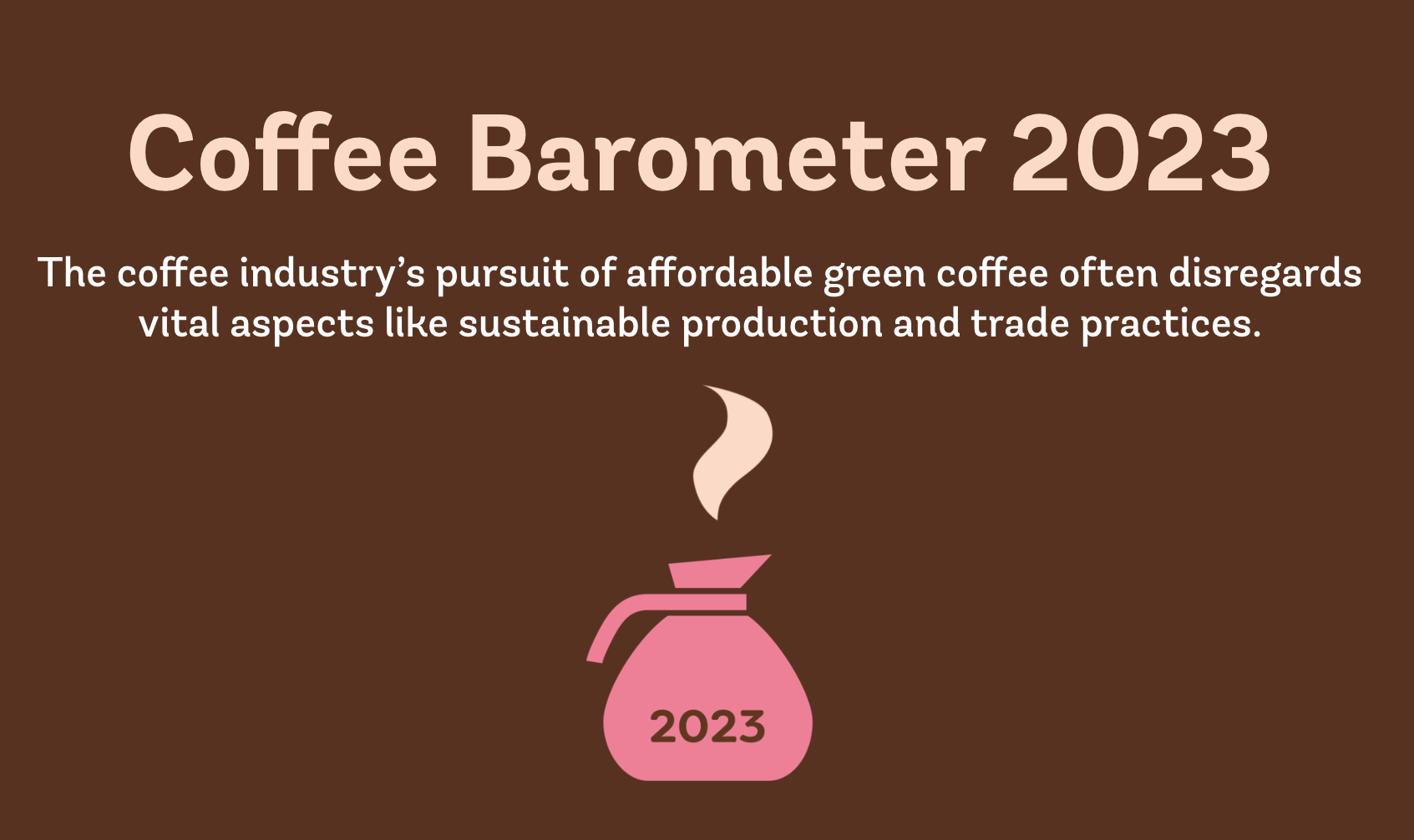As it has in past editions, the Coffee Barometer made a massive splash throughout the coffee industry upon its latest release two weeks ago, as it outlined some of the largest failures (and opportunities) related to corporate sustainability in coffee.
The report and its companion interactive website read something like a counterpoint to typical corporate sustainability reports in which companies conveniently ignore the fact that they are contributors to — or beneficiaries of — the very problems that they are claiming to solve.
As the 2023 Coffee Barometer points out, the problems facing the global coffee sector and the industry that depends on it are manifold — including sustained low prices and volatility, climate change, regulatory issues affecting the most vulnerable farmers and workers, and a lack of meaningful sustainability participation from many of the world’s largest coffee companies.
It’s also important to note that the Coffee Barometer points out the ways in which some large companies are indeed affecting positive changes within their own supply chains and the coffee sector as a whole.
This year, those dynamics are expressed through the Coffee Brew Index, a visual guide that ranks the sustainability efforts of 11 of the world’s largest coffee roasters in different sustainability arenas.
As the 2023 Coffee Barometer continues to make waves throughout the industry, DCN recently caught up with its two lead authors — Sjoerd Panhuysen and Frederik de Vries of the sustainability research and consulting firm Ethos Agriculture — to learn more.
[Note: The 2023 Coffee Barometer was initiated by the NGOs Conservation International and Solidaridad and produced by Ethos Agriculture. Answers below are attributed jointly to Panhuysen and de Vries. Questions and answers have been lightly edited for clarity.]
Daily Coffee News: Can you briefly describe the history of the Coffee Barometer, including why it exists and for whom it exists?
Authors: The CB has a long history. A consortium of NGOs has initiated it in 2006 because of a very simple question: How are the major players in the coffee sector contributing to its sustainability, relative to the scale of their global coffee operations?
While the participating NGOs have changed, we have been able to release a report every couple of years, each edition presenting a broad perspective of the main sustainability challenges, evolving trends within the industry, and the pivotal role played by key coffee companies. By combining research with infographics, the report has evolved into an influential source in the sector’s sustainability discussions.
How and why were each of the 11 coffee companies identified in the report selected?
Our focus extends to coffee roasting companies operating on a global scale, boasting large brand portfolios and a significant presence in major markets. Together the 11 companies in our overview are responsible for roasting more than one third of the world’s coffee, so they have a considerable responsibility for improving the challenges the sector is facing. Our ambition is to broaden our scope to encompass a more diverse array of companies, including traders, retailers and additional roasters.
The report outlines how sustainability initiatives among some of the world’s largest companies have progressed (or not, in terms of outcomes) over the years. It highlights both progress and stasis. As people deeply entrenched in the report, what do you make of this? In other words, if a goal of the Coffee Barometer is to inspire progress towards sustainability in the coffee industry, how has it performed?
The CB tries to bring the issue of scale — in volume, people, money, time, etc. — into the sectors’ consciousness. The stark reality is that sustainability challenges cannot be effectively tackled with sporadic projects and vague commitments.
Over the years, we’ve seen a shift in the discourse towards more authentic engagement — for example, by focusing on the potential to earn a living income and the necessary investments to adapt to climate change. However, the current mixture of issues — poverty and the inability for most small-scale coffee farmers to generate a decent profit of their coffee production, and the need to invest in adapting the whole sector to climate change — pose immense challenges.
We hold the reasonable expectation that major roasters bear a shared responsibility and should have a plan of action combined with a willingness to invest the necessary resources in the sector.
Nonetheless, as the Coffee Brew Index clearly illustrates, all the companies are lacking in their efforts to bolster the economic viability of coffee farmers. It’s good to see that the discussions about sustainability have become more profound; however, they predominantly center on practices at the farm level. It’s evident that the issue of inadequate economic retention must be addressed, too. Thus, it’s high time to direct our attention towards the trade system itself, whereby companies could take immediate responsibility by refining their procurement policies and reshaping them to favor their small-scale farmer suppliers.
As longtime reviewers of corporate sustainability reports in the coffee industry, how would you characterize the current state of corporate sustainability reporting, as compared to, say, 10 years ago?
The challenge is that all companies can share whatever they like… In general, the quality and comparability of the companies’ sustainability reporting is not really sufficient to understand their strategy. For instance, none of the companies actually reports anything about their investments in improving the social and environmental challenges in their supply chains.
Another issue is the lack of consistency. Some roasters still fail to produce a sustainability report on a yearly basis. Imagine [if] they would skip their financial report, or postpone it a few months? This underlines our impression that voluntary reporting on ESG (environmental, social and governance) is not working.
Still this is surprising, for instance, the EU’s Corporate Sustainability Reporting Directive (CSRD) entered into force beginning of 2023. One would expect all these large companies to be proactive and have their act together: the detailed company profiles on our website www.coffeebarometer.org show that the opposite is often true.
The 2023 Coffee Barometer focuses largely large multinational companies. What actions might relatively small coffee traders or roasting companies take if they want to be proactive regarding sustainability reporting?
There are excellent examples of smaller companies punching way above their weight in fostering sustainability in the coffee sector. With interesting and engaging reports, following international reporting guidelines (eg. of GRI, Certified B Corp), they are able to inspire the sustainability discourse.
It’s good to share your vision with the broader coffee community and inform consumers about the challenges and reality in many coffee producing countries. Probably, the real innovation is coming from smaller roasters experimenting with new business models that challenge the business-as-usual model.
With well-defined strategies and reporting mechanisms that encompass crucial elements like transparency, traceability, supplier engagement, monitoring and sector collaboration, companies will be able to effectively address the social and environmental impacts within their coffee supply chains. Ideally, coffee-specific sustainability strategies would involve farm-level investments and activities that are embedded into supply chains based on identified risks and local needs.
Does your coffee business have news to share? Let DCN’s editors know here.
Nick Brown
Nick Brown is the editor of Daily Coffee News by Roast Magazine.









Comment